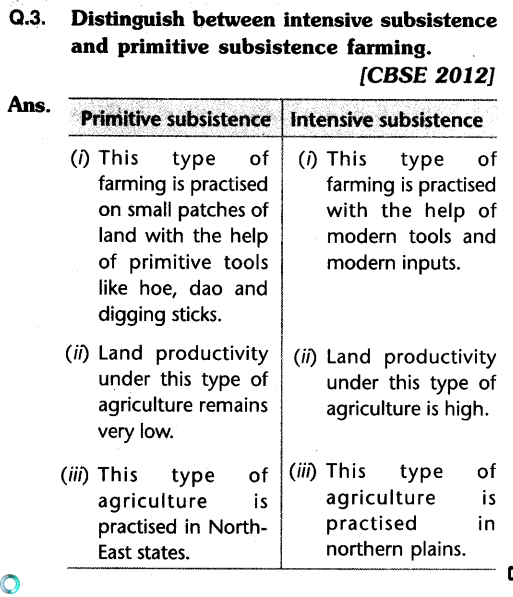Exploring the Distinctions In Between Commercial Farming and Subsistence Farming Practices
The dichotomy between business and subsistence farming techniques is noted by differing purposes, operational ranges, and resource application, each with profound effects for both the atmosphere and society. Alternatively, subsistence farming highlights self-sufficiency, leveraging traditional techniques to sustain family needs while supporting community bonds and cultural heritage.
Economic Purposes
Economic objectives in farming practices typically dictate the approaches and range of operations. In commercial farming, the primary financial goal is to maximize profit.
In contrast, subsistence farming is mainly oriented in the direction of fulfilling the instant requirements of the farmer's household, with surplus manufacturing being marginal - commercial farming vs subsistence farming. While industrial farming is profit-driven, subsistence farming is centered around sustainability and strength, reflecting an essentially various collection of economic imperatives.

Range of Workflow
When thinking about the range of operations,The difference in between commercial and subsistence farming ends up being especially apparent. Business farming is identified by its large nature, usually including comprehensive systems of land and using advanced machinery. These operations are usually integrated into global supply chains, creating huge quantities of plants or animals meant offer for sale in global and residential markets. The range of business farming enables economic climates of scale, resulting in minimized costs per system via automation, increased effectiveness, and the capacity to purchase technological innovations.
In stark contrast, subsistence farming is normally small, focusing on generating simply sufficient food to fulfill the instant demands of the farmer's family members or regional area. The land location included in subsistence farming is frequently minimal, with less access to modern-day technology or mechanization.
Resource Utilization
Business farming, identified by large-scale operations, often utilizes innovative modern technologies and mechanization to enhance the usage of resources such as land, water, and fertilizers. Precision farming is increasingly adopted in industrial farming, utilizing data analytics and satellite innovation to monitor plant wellness and enhance resource application, further boosting return and source efficiency.
On the other hand, subsistence farming operates a much smaller sized scale, primarily to satisfy the immediate demands of the farmer's house. commercial farming vs subsistence farming. Resource use in subsistence farming is often restricted by economic restraints and a dependence on traditional techniques. Farmers commonly make use of manual work and natural deposits readily available in your area, such as rain and organic garden compost, to cultivate their crops. The focus is on sustainability and self-reliance as opposed to maximizing output. Subsistence farmers might deal with obstacles in resource administration, consisting of limited access to boosted seeds, fertilizers, and watering, which can restrict their capability to improve efficiency and success.
Environmental Effect

Conversely, subsistence farming, exercised on a smaller scale, usually uses typical strategies that are much more in consistency with the surrounding environment. Crop rotation, intercropping, and organic fertilization prevail, advertising dirt wellness and reducing the requirement for synthetic inputs. While subsistence farming usually has a reduced environmental footprint, it is not without difficulties. Over-cultivation and inadequate land monitoring can bring about dirt erosion and deforestation in many cases.
Social and Cultural Implications
Farming practices are deeply linked with the social and cultural material of areas, influencing and mirroring their values, traditions, and economic frameworks. In subsistence farming, the focus is on cultivating enough food to meet the prompt demands of the farmer's household, often promoting a solid feeling of community and shared duty. Such methods are deeply rooted in local traditions, with understanding gave via generations, thereby protecting cultural heritage and enhancing common ties.
On the other hand, commercial farming is primarily driven by market needs and success, usually leading to a change in the direction of monocultures and massive operations. This approach can cause the disintegration of typical farming techniques and cultural identifications, as local customizeds and understanding are like this supplanted by standard, industrial approaches. The focus on performance and revenue can occasionally diminish the social communication found in subsistence areas, navigate to these guys as economic purchases change community-based exchanges.
The duality between these farming techniques highlights the broader social ramifications of farming selections. While subsistence farming sustains cultural continuity and neighborhood interdependence, industrial farming lines up with globalization and financial development, typically at the expense of conventional social frameworks and social variety. commercial farming vs subsistence farming. Stabilizing these aspects continues to be an essential obstacle for lasting agricultural advancement
Final Thought
The assessment of commercial and subsistence farming techniques exposes considerable distinctions in purposes, scale, source use, environmental impact, and social implications. On the other hand, subsistence farming stresses self-sufficiency, making use of local resources and standard methods, thus advertising social conservation and community cohesion.
The duality between industrial and subsistence farming practices is noted by varying objectives, operational ranges, and resource utilization, each with extensive ramifications for both the environment and society. While commercial farming is profit-driven, subsistence farming is focused around sustainability and strength, reflecting a fundamentally various collection of economic imperatives.
The distinction between business and subsistence farming comes to be Find Out More especially obvious when taking into consideration the scale of procedures. While subsistence farming sustains cultural connection and community connection, commercial farming lines up with globalization and economic development, often at the cost of standard social structures and cultural diversity.The assessment of business and subsistence farming practices reveals considerable differences in purposes, scale, resource usage, ecological effect, and social implications.